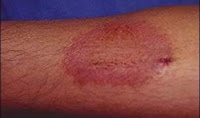 |
| Contact Dermatitis causes, symptoms, and treatment |
Contact dermatitis is an inflammation attributable to exposure to a certain substance; rash is confined to specific areas and infrequently have strict limits.
CAUSE
Certain substances may cause inflammation on the epidermis in 2 ways, namely irritation (irritant contact dermatitis) or allergic attack (allergic contact dermatitis).
Very mild soap, detergents and certain metals can irritate the skin after a few times use.
Sometimes repeated exposure could potentially cause skin dryness and irritation.
In seconds, strong irritants (eg, acids, alkalis and several organic solvents) could cause modifications to your skin.
Inside allergic reaction, the primary experience of a unique substance doesn't result in a reaction, but subsequent exposure could potentially cause itching and dermatitis within 4-a day.
Someone could have used a substance for decades without any problems, then suddenly experience an hypersensitivity. Even ointments, lotions and creams which might be utilized to treat dermatitispun may cause hypersensitivity.
Approximately 10% of girls are allergic to nickel.
Dermatitis can also happen due to a selection of materials based in the workplace (occupational dermatitis).
If dermatitis occurs after touching certain substances and exposed to the sun's rays, then the condition is referred to as contact dermatitis or contact dermatitis phototoxic fotoalergika.
These substances include sunscreen, after-shave lotions, perfume, antibiotics and oil.
What may cause allergic contact dermatitis:
# Cosmetics: nail varnish, nail polish remover, deodorant, moisturizer, after shave lotions, perfumes, sunscreen
# Chemical compounds (in jewelery): nickel
# Plants: poison ivy (vines), poison oak, a variety of wild grass, primros
# The medications from skin creams: antibiotics (penicillin, sulfonamides, neomycin), antihistamines (diphenhydramine, promethazine), anesthetics (benzocaine), antiseptic (Thimerosal)
# A chemical employed in the processing of clothing.
SYMPTOMS
Effect of contact dermatitis varies, starting from mild redness in support of lasted a moment till the skin blisters and severe swelling.
Rash often consist of small itchy blisters (vesicles).
Initially rash confined to areas in direct hitting the ground with an allergen (substances causing allergy symptoms), nevertheless the rash can spread further.
The rash can be quite small (eg holes for earrings) or can cover large areas of the body (eg dermatitis a result of the utilization of body lotions).
If your rash-causing substance is not really used, usually with a couple of days redness will disappear.
Blisters will burst and ooze fluid and form a scab after which it dried.
Remnants of scales, itching and thickening of the epidermis that is certainly temporary, may last for several days or weeks.
Diagnosis
The diagnosis is dependant on symptoms as well as a good reputation for hitting the ground with irritants or allergens.
In case a suspected contact dermatitis, patch tests can be carried out.
A small plaster containing substances that commonly cause dermatitis pendeita put on your skin for two main days to find out should the kind of a rash under on the list of plaster.
Other tests are employed to eliminate other possible causes are breeding biopsy or wound within the skin.
TREATMENT
Treatment solutions are made by eliminating or avoiding substances cause contact dermatitis.
In order to avoid infection avoiding irritation, the affected region really should be cleaned regularly with water and gentle soap. Blisters must not be broken. Dry bandages can also prevent infection.
Corticosteroid creams or ointments can usually relieve the symptoms of mild contact dermatitis.
Corticosteroid tablets can be employed in severe cases.
In certain circumstances antihistamine can relieve itching.
PREVENTION
Prevention of contact dermatitis means avoiding hitting the ground with substances including poison oak or harsh soaps which could cause it. Prevention strategies include:
1. Rinse skin with water and use a gentle soap if dermatitis on account of hitting the ground with a substance. Try washing to remove many irritants or allergens out of your skin. Make sure to rinse the soap completely through your body.
2. Wear cotton or plastic gloves when you are conducting household chores to prevent connection with cleaners or solvents.
3. If at the office, wear protective clothing or gloves to defend your skin layer against harmful compounds.
4. Apply a cream or gel barrier for your skin to provide a protective coating. Also, make use of a moisturizer to bring back the skin's outer layer and also to prevent moisture evaporation.
5. Use mild detergent without fragrance when washing clothes, towels and blankets. Try to do another rinse cycle from the washing machine.

